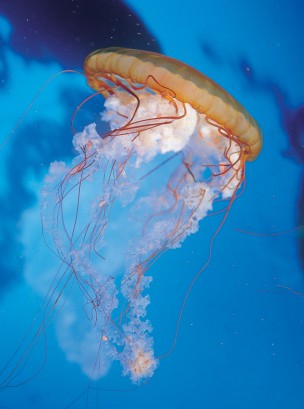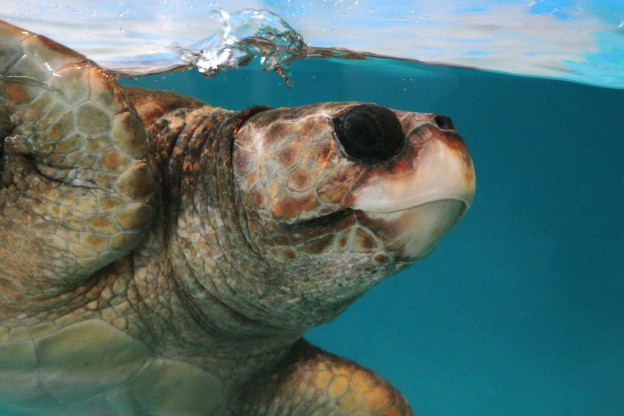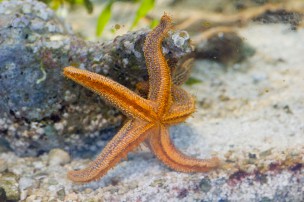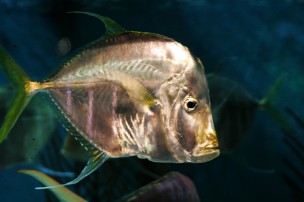Photo by Marc Ellis courtesy of Mote Aquarium
All sea turtle species are considered threatened or endangered and all deserve protection
Hayley Rutger, Mote’s public relations specialist

Coastal Life
The fragile ecosystem along our shore demands our Respect—and protection
Our Gulf Coast—it’s a world of unparalleled beauty and intrigue, a universe of underwater creatures from manatees and dolphins to delicate seahorses and endangered sea turtles.
Plant life such as sea grass meadows and marine invertebrates like coral reefs act as a refuge for this marine life. The vast Gulf ecosystem continues along the shoreline, too, in wetland vegetation. Here, mangrove forests provide food, shelter and nursery areas for fish, crustaceans and shellfish, as well as nesting grounds for shorebirds.
Indeed, our shoreline is a complex web of living organisms, where one form of life nurtures and sustains another. Now, however, it may be permanently changed by the intrusion of a devastating oil spill, wreaking havoc on the sensitive marshlands, marine life, the habitat of nesting birds and our beautiful beaches. This means it is more important than ever for those of us living along the coast to be stewards of this fragile environment—there is much at stake.
SEA TURTLE NESTING SEASON
While all marine life is sensitive to pollution, it is the endangered species such as the manatee and sea turtles that need our attention the most.
Take a stroll along the beach this time of year and you’re likely to see a small staked-off area with orange tape. The west coast of Florida is a common nesting ground for sea turtles including the green turtle, loggerhead, hawksbill, Kemp’s Ridley and the leatherback.
Mote Marine Laboratory’s Center for Sea Turtle Research in Sarasota is one of the world’s leading marine research centers. Each summer between May and October, program staff and volunteers monitor 35 miles of nesting beaches daily in Sarasota County.
“All sea turtle species are considered threatened or endangered and all deserve protection,” says Hayley Rutger, Mote’s public relations specialist. “Based on nesting data collected by Mote Marine Laboratory, green sea turtles have shown an increase in nesting over the past 20 years around the state, but loggerhead sea turtles seem to be showing nesting declines.”
At Clearwater Marine Aquarium, a turtle watch program patrols 26 miles of Pinellas County coastline during nesting season. Both programs rely on volunteers to keep vigil by monitoring nesting sites and setting up cages to protect nests from predators.

DON’T TOUCH THE MANATEES!
Colder winter months can guarantee manatee sightings at Teco’s Big Bend power plant in Apollo Beach where they are drawn to the warm-water discharge. But it’s not uncommon to encounter the friendly sea cows during summer months in the shallow, slow-moving rivers, bays, estuaries and coastal waters around Tampa Bay.
Dr. Katie Tripp, director of Science and Conservation for the Save the Manatee Club based in Maitland, advises divers, swimmers and boaters not to feed or touch the manatees should you have a close encounter.
“First, any form of interaction is considered harassment and is illegal under federal and state laws,” says Tripp. “Second, even though they seem curious and friendly, you have to remember that manatees are wild creatures. You don’t want them to form an attachment to humans … so it’s best to just observe from a distance.”
SHOREBIRDS NEED PROTECTION
For bird-lovers, the West Coast of Florida is like a slice of heaven. Many shorebird species live here year round, such as pelicans, anhingas, egrets, herons, roseate spoonbills and ibis. This coast is also a popular migratory route for many avian species traveling from Canada and North America to South America each winter. Along the shore of Tampa Bay are breeding colonies where thousands of birds of some 25 species come to rear their young. These large colonies are found on coastal islands, where nests are safe from predators and disturbance.
At Honeymoon Island State Park and Caladesi Island in Dunedin, a cooperative program between Clearwater Audubon and the Florida Park Service recruits volunteers to protect nesting shorebirds during summer months. Nearly two dozen volunteers have been trained for the 2010 nesting season, says Dan Larremore, state park environmental specialist at Honeymoon Island. Their mission: to keep marauding boaters and their dogs away from active nesting sites. “This area is one of the three top nesting spots in the state,” says Larremore.
“We get threatened and endangered species like snowy plovers, Least terns, the American oystercatcher and Wilson’s plover … that’s why we do the program.”
At the Suncoast Seabird Sanctuary in Indian Shores, staff and volunteers are dedicated to the rescue, rehabilitation and release of injured seabirds and shorebirds. They seem to be busiest during the summer months when fishing peaks. “The most common shorebird injuries we see are pelicans caught in fishing line and fishhooks,” says Public Relations Manager Michelle Simoneau. “But we’ll rescue just about any bird in distress.”
The sanctuary works with environmental groups across the Gulf Coast, accepting injured and distressed birds at their nationally-renowned wild bird hospital. It is staffed by experienced professionals assisted by over a hundred dedicated volunteers. Similar to a human hospital, it is equipped with emergency facilities, a surgical center and indoor and outdoor rehabilitation areas.
The uncertainty and dread surrounding the Gulf oil disaster must serve as a catalyst to reinvigorate our sense of urgency to protect and preserve our precious coastal environment and its inhabitants at all costs. Only with our dedication and willingness to help will it survive.
WHAT YOU CAN DO
Report sightings of injured shorebirds to Suncoast Seabird Sanctuary at 1.866.557.1401. To volunteer call 727.392.4291 or visit www.seabirdsanctuary.com.
If you spot an injured marine mammal or sea turtle, call the Clearwater Marine Aquarium 24-hour hotline at 727.441.1790 or visit www.seewinter.com. In Sarasota county, contact Mote Marine Laboratory and Aquarium at 941.388.4441 or visit www.mote.org


 Get VERTICAL…and be part of something Fabulous!!!
Get VERTICAL…and be part of something Fabulous!!!